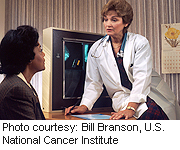- Skip Storing This Everyday Product in the Fridge Door
- Green Tea + B3 Pairing May Boost Brain Health
- Navigating Your Midlife Crisis: Embracing New Possibilities
- City Raccoons Showing Signs of Domestication
- Mapping the Exposome: Science Broadens Focus to Environmental Disease Triggers
- One Week Less on Social Media Linked to Better Mental Health
- Your Brain Changes in Stages as You Age, Study Finds
- Some Suicide Victims Show No Typical Warning Signs, Study Finds
- ByHeart Formula Faces Lawsuits After Babies Sickened With Botulism
- Switch to Vegan Diet Could Cut Your Greenhouse Gas Emissions in Half
Doctor’s Eye Contact Strengthens Bond With Patient, Study Finds


SATURDAY, Oct. 19When it comes to bedside manner, the eyes have it. That’s the message of a new study that suggests patients like doctors who make eye contact and think they’re more empathetic.
“The goal is to one day engineer systems and technologies that encourage the right amount of physician eye contact and other nonverbal social communication,” study co-author Enid Montague, an assistant professor in medicine, general internal medicine and geriatrics at Northwestern University Feinberg School of Medicine, said in a university news release.
“As we collect more data we can build models that tell us exactly how much eye contact is needed to help patients trust and connect with a doctor, and design tools and technology that help doctors stay connected to patients,” added Montague, who is also an assistant professor in the McCormick School of Engineering and Applied Sciences.
The researchers came to their conclusions after studying video of 110 first-time visits between primary care physicians and patients who had cold symptoms. The visits were brief, at an average of 3 minutes and 38 seconds each, and featured the use of paper charts at a time when many physicians are moving to computer systems.
“Previous studies have found that nonverbal communication is important based on patient feedback, but this is one of the few that have looked at these things more broadly quantitatively,” Montague said. “We rigorously looked at what was happening at every point in time, so we validated a lot of the qualitative studies.”
Patients filled out questionnaires after the visits. They thought doctors were more empathetic when the visits were longer and when the physicians touched them a few times, such as through a handshake or pat on the back. But patients seemed to be turned off by more than three touches, perhaps because they came across as fake.
“Simple things such as eye contact can have a big impact on our health care system as a whole,” Montague said. “If patients feel like their doctors aren’t being empathetic, then we are more likely to see patients who aren’t returning to care, who aren’t adhering to medical advice, who aren’t seeking care, who aren’t staying with the same providers. If they switch providers, that’s very costly for the health care system.”
The study recently appeared in the Journal of Participatory Medicine.
More information
For tips about how to talk with your doctor, try the U.S. National Library of Medicine.
Source: HealthDay
Copyright © 2025 HealthDay. All rights reserved.










